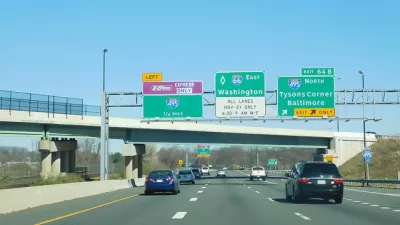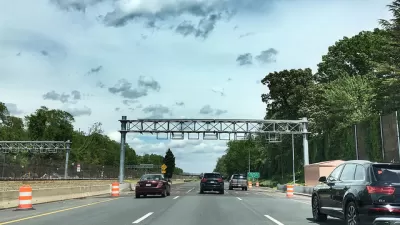An illustration of the intricate relationship between public transit and highways occurred on April 5 when two lines of the D.C. Metro broke down during the peak morning commute, sending many would-be riders to drive I-66 to D.C. instead.
"Metro had a nearly two-hour shutdown [from about 6:15 to 8 a.m.] on part of its Orange and Silver lines after smoke was reported at the Virginia Square station and in tunnels between Clarendon and Ballston" in Arlington, Va., reports Dana Hedgpeth for The Washington Post.
The influx of new drivers on Interstate 66 inside the Beltway who would otherwise have ridden the subway caused congestion, slowing speeds on the general purpose lanes. For solo drivers wanting a faster commute by opting to use the tolled 66 Express Lanes, which applies congestion pricing, i.e., the tolls increase with the level of congestion to keep minimum speeds above 45 mph, it wouldn't come cheap. Unlike many of the nation's other express lanes, the tolls have no upper limit, i.e., they are uncapped.
The $47 [eastbound morning] toll for the 10-mile stretch inside the Beltway was the third highest since the lanes made their debut in December. The high was $47.50 on Feb. 28 [see below], according to figures from the Virginia Department of Transportation.
The toll system is based on a “dynamic pricing” system that changes every six minutes, depending on demand, traffic and speed.
Not all vehicles using the express lanes pay tolls though. Drivers with at least one passenger traveled toll-free as the lanes are also high occupancy toll (HOT) lanes. Motorcyclists also travel toll-free. However, Teslas and other clean cars get no break without passengers.
Metro breakdowns not uncommon
Last Thursday's Metro breakdowns causing the 66 Express Lanes tolls to skyrocket was no anomaly.
On Feb. 28, there were lengthy delays for Metro riders on the Orange and Silver lines after a train had a brake problem at the Ballston station. Metro shut down rail service on part of the lines for about an hour. On that day, the eastbound I-66 toll peaked at $47.50, setting the record.
The subway-road toll relationship illustrates why it is good public policy to allow toll revenues to be used to improve transit service. Tolling need not be restricted to highways but also considered for urban cordons, as proposed in New York, Seattle, and potentially four California cities, to improve urban transit as well as other travel alternatives.
FULL STORY: ‘Took 3 hours to get to work’: Metro service suspension, $47 toll frustrate Virginia commuters

Alabama: Trump Terminates Settlements for Black Communities Harmed By Raw Sewage
Trump deemed the landmark civil rights agreement “illegal DEI and environmental justice policy.”

Planetizen Federal Action Tracker
A weekly monitor of how Trump’s orders and actions are impacting planners and planning in America.

How Atlanta Built 7,000 Housing Units in 3 Years
The city’s comprehensive, neighborhood-focused housing strategy focuses on identifying properties and land that can be repurposed for housing and encouraging development in underserved neighborhoods.

In Both Crashes and Crime, Public Transportation is Far Safer than Driving
Contrary to popular assumptions, public transportation has far lower crash and crime rates than automobile travel. For safer communities, improve and encourage transit travel.

Report: Zoning Reforms Should Complement Nashville’s Ambitious Transit Plan
Without reform, restrictive zoning codes will limit the impact of the city’s planned transit expansion and could exclude some of the residents who depend on transit the most.

Judge Orders Release of Frozen IRA, IIJA Funding
The decision is a victory for environmental groups who charged that freezing funds for critical infrastructure and disaster response programs caused “real and irreparable harm” to communities.
Urban Design for Planners 1: Software Tools
This six-course series explores essential urban design concepts using open source software and equips planners with the tools they need to participate fully in the urban design process.
Planning for Universal Design
Learn the tools for implementing Universal Design in planning regulations.
Jessamine County Fiscal Court
Caltrans
Institute for Housing and Urban Development Studies (IHS)
City of Grandview
Harvard GSD Executive Education
Toledo-Lucas County Plan Commissions
Salt Lake City
NYU Wagner Graduate School of Public Service




























